La Trobe University: MGT5EBP Contemporary Issue Report on Tech
VerifiedAdded on 2022/09/28
|15
|3234
|22
Report
AI Summary
This report delves into the contemporary issue of disruptive technologies and their profound impact on entrepreneurship. It begins with an executive summary highlighting the significance of entrepreneurship in economic growth and introduces the core issue of disruptive technologies. The report defines disruptive technologies and their relevance to entrepreneurs, discussing the challenges they face, such as adapting to rapid technological changes and the need for continuous innovation. It explores how disruptive technologies affect the entrepreneurial venture lifecycle, particularly during the initial stages. The report also examines how entrepreneurs can address these challenges by understanding market trends, fostering innovation, and adopting strategic approaches. The analysis is based on secondary research, including peer-reviewed articles and industry publications. It emphasizes the importance of adapting to new technologies and the need for entrepreneurs to remain agile to succeed in today's dynamic business environment.
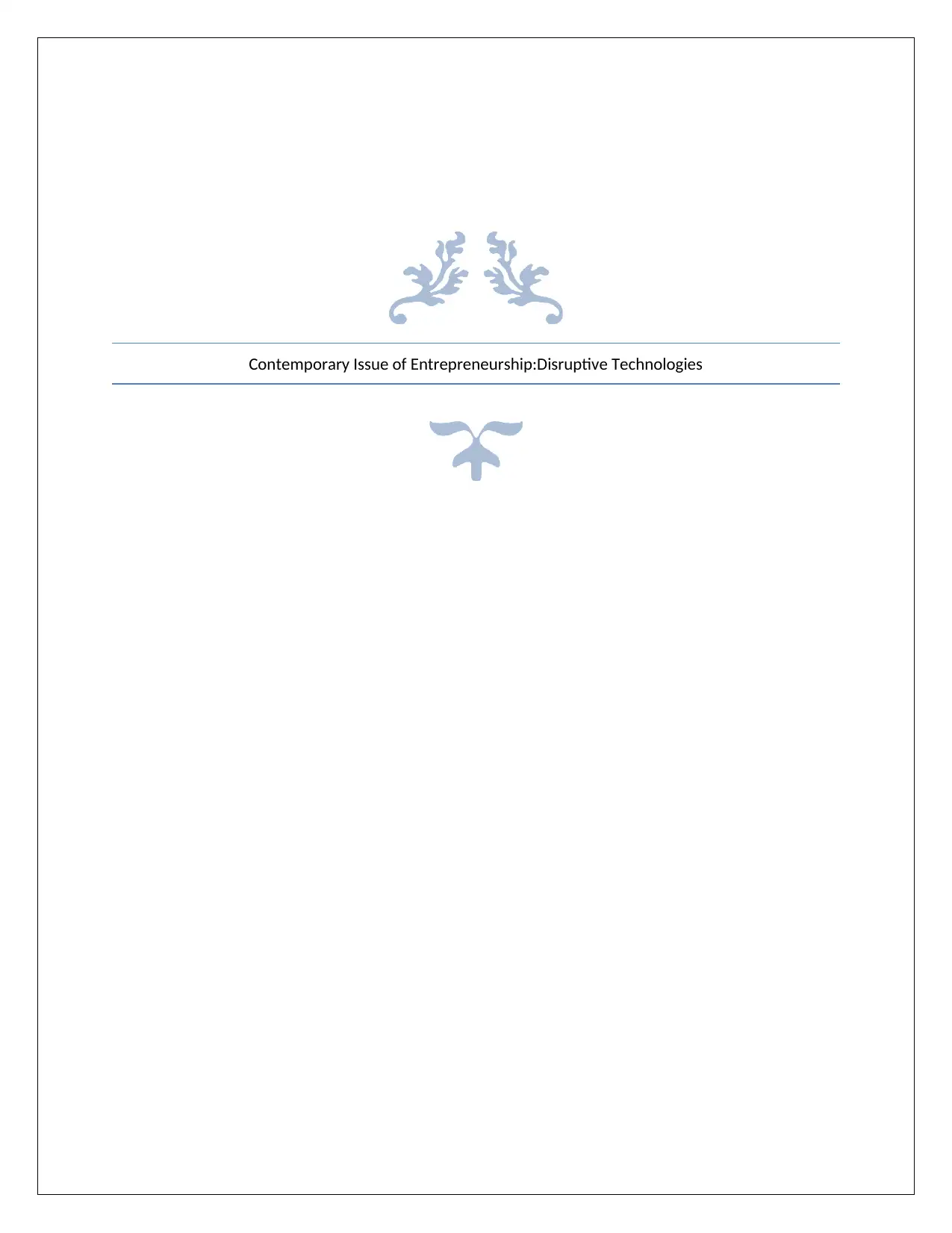
Contemporary Issue of Entrepreneurship:Disruptive Technologies
Paraphrase This Document
Need a fresh take? Get an instant paraphrase of this document with our AI Paraphraser
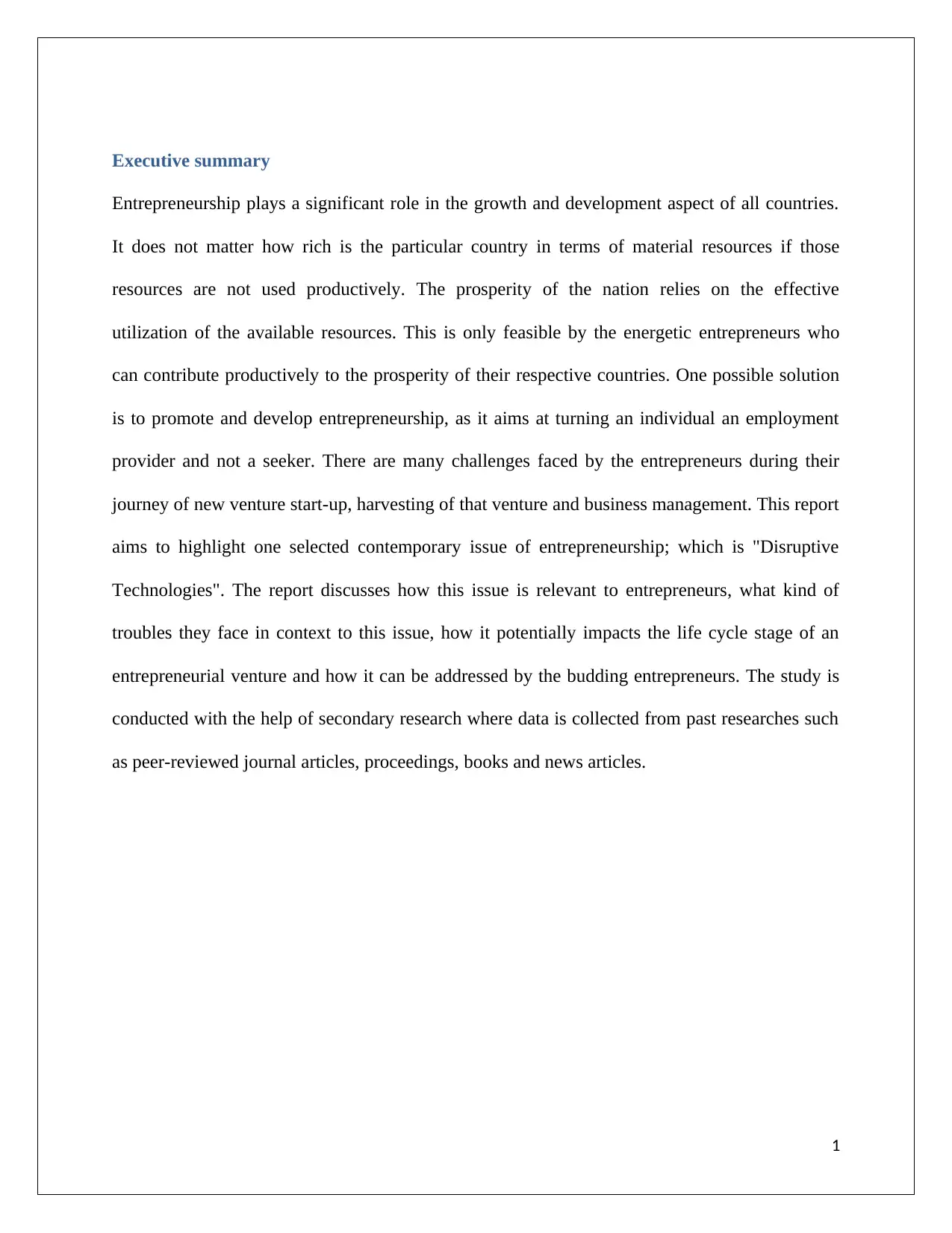
Executive summary
Entrepreneurship plays a significant role in the growth and development aspect of all countries.
It does not matter how rich is the particular country in terms of material resources if those
resources are not used productively. The prosperity of the nation relies on the effective
utilization of the available resources. This is only feasible by the energetic entrepreneurs who
can contribute productively to the prosperity of their respective countries. One possible solution
is to promote and develop entrepreneurship, as it aims at turning an individual an employment
provider and not a seeker. There are many challenges faced by the entrepreneurs during their
journey of new venture start-up, harvesting of that venture and business management. This report
aims to highlight one selected contemporary issue of entrepreneurship; which is "Disruptive
Technologies". The report discusses how this issue is relevant to entrepreneurs, what kind of
troubles they face in context to this issue, how it potentially impacts the life cycle stage of an
entrepreneurial venture and how it can be addressed by the budding entrepreneurs. The study is
conducted with the help of secondary research where data is collected from past researches such
as peer-reviewed journal articles, proceedings, books and news articles.
1
Entrepreneurship plays a significant role in the growth and development aspect of all countries.
It does not matter how rich is the particular country in terms of material resources if those
resources are not used productively. The prosperity of the nation relies on the effective
utilization of the available resources. This is only feasible by the energetic entrepreneurs who
can contribute productively to the prosperity of their respective countries. One possible solution
is to promote and develop entrepreneurship, as it aims at turning an individual an employment
provider and not a seeker. There are many challenges faced by the entrepreneurs during their
journey of new venture start-up, harvesting of that venture and business management. This report
aims to highlight one selected contemporary issue of entrepreneurship; which is "Disruptive
Technologies". The report discusses how this issue is relevant to entrepreneurs, what kind of
troubles they face in context to this issue, how it potentially impacts the life cycle stage of an
entrepreneurial venture and how it can be addressed by the budding entrepreneurs. The study is
conducted with the help of secondary research where data is collected from past researches such
as peer-reviewed journal articles, proceedings, books and news articles.
1
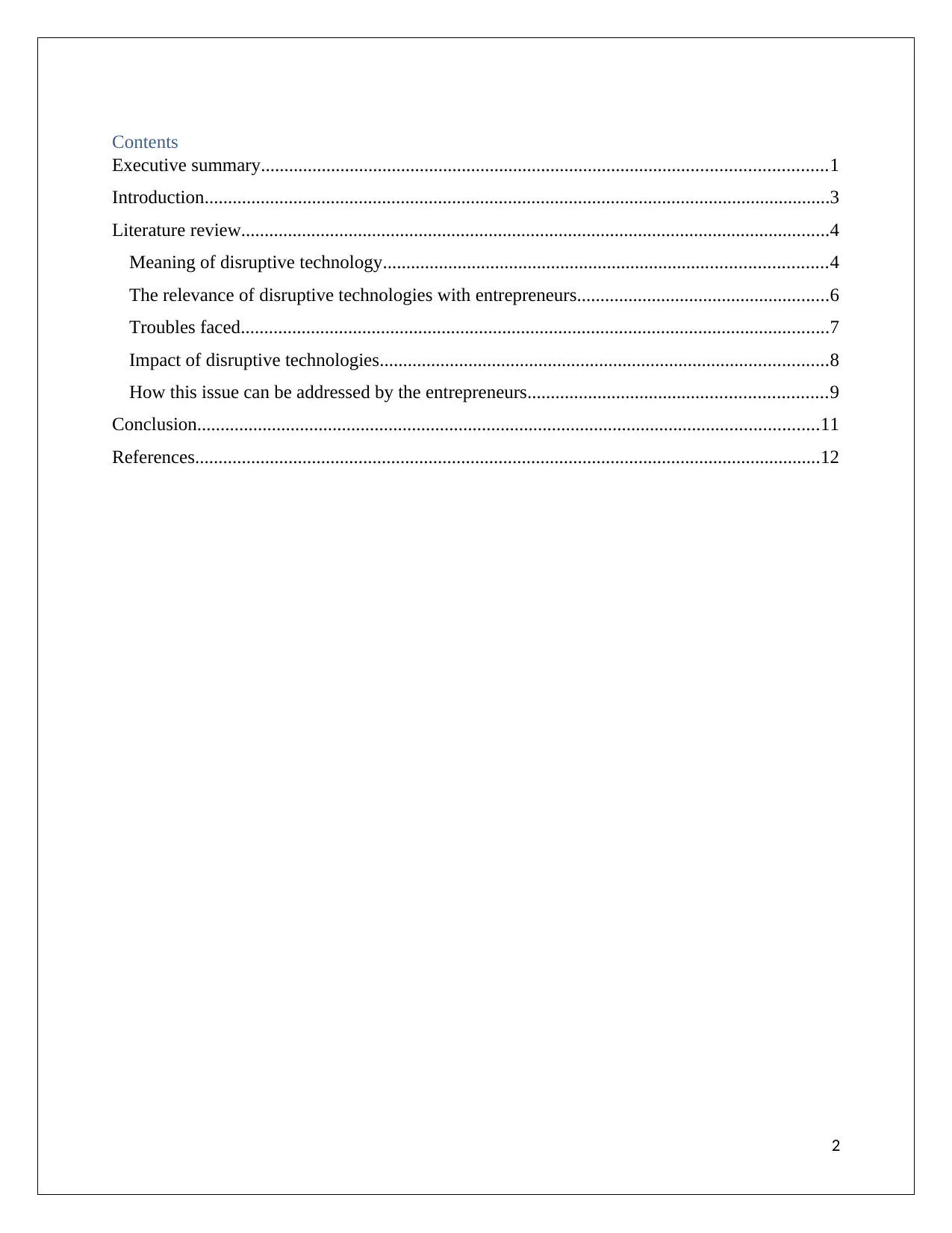
Contents
Executive summary.........................................................................................................................1
Introduction......................................................................................................................................3
Literature review..............................................................................................................................4
Meaning of disruptive technology...............................................................................................4
The relevance of disruptive technologies with entrepreneurs......................................................6
Troubles faced..............................................................................................................................7
Impact of disruptive technologies................................................................................................8
How this issue can be addressed by the entrepreneurs................................................................9
Conclusion.....................................................................................................................................11
References......................................................................................................................................12
2
Executive summary.........................................................................................................................1
Introduction......................................................................................................................................3
Literature review..............................................................................................................................4
Meaning of disruptive technology...............................................................................................4
The relevance of disruptive technologies with entrepreneurs......................................................6
Troubles faced..............................................................................................................................7
Impact of disruptive technologies................................................................................................8
How this issue can be addressed by the entrepreneurs................................................................9
Conclusion.....................................................................................................................................11
References......................................................................................................................................12
2
⊘ This is a preview!⊘
Do you want full access?
Subscribe today to unlock all pages.

Trusted by 1+ million students worldwide
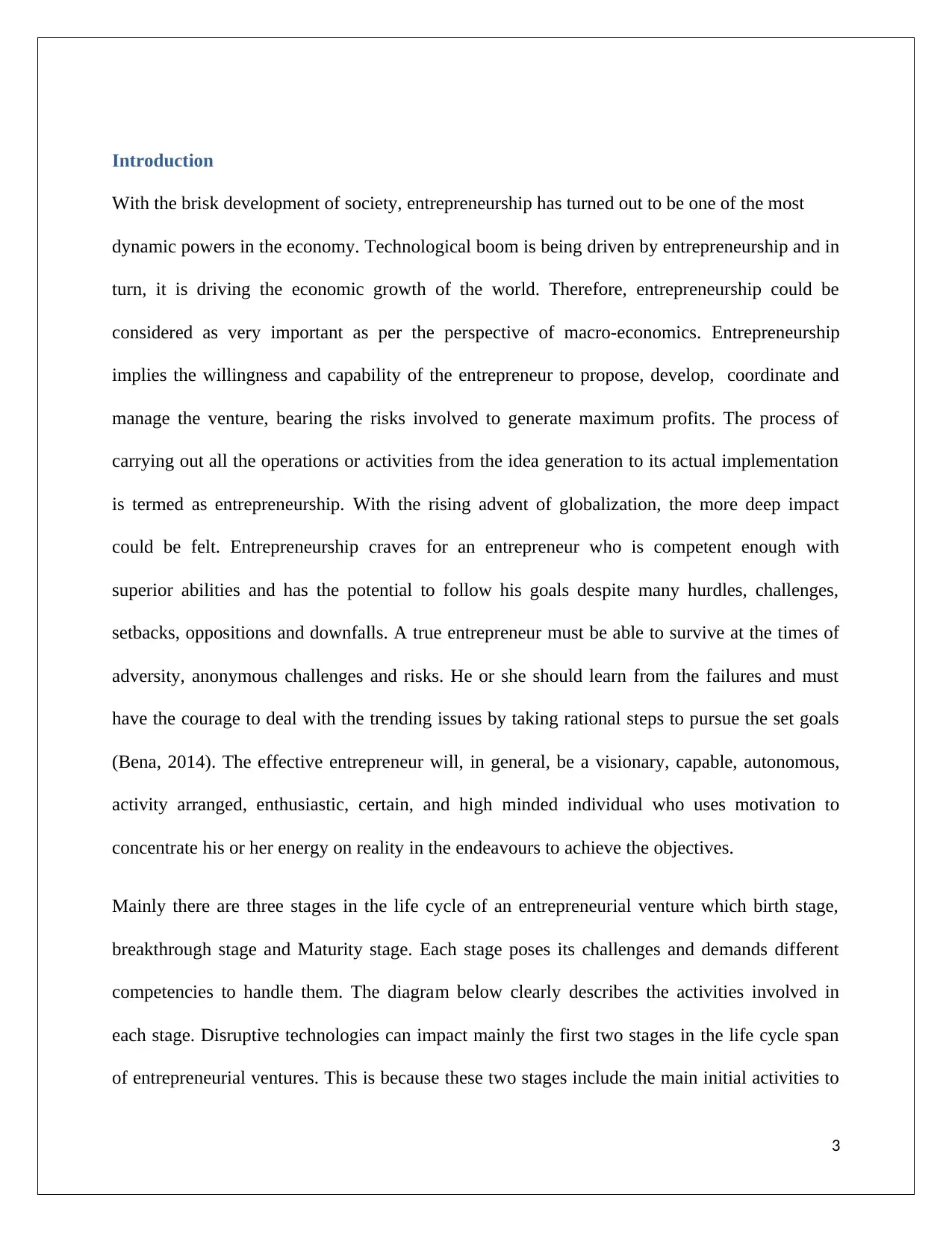
Introduction
With the brisk development of society, entrepreneurship has turned out to be one of the most
dynamic powers in the economy. Technological boom is being driven by entrepreneurship and in
turn, it is driving the economic growth of the world. Therefore, entrepreneurship could be
considered as very important as per the perspective of macro-economics. Entrepreneurship
implies the willingness and capability of the entrepreneur to propose, develop, coordinate and
manage the venture, bearing the risks involved to generate maximum profits. The process of
carrying out all the operations or activities from the idea generation to its actual implementation
is termed as entrepreneurship. With the rising advent of globalization, the more deep impact
could be felt. Entrepreneurship craves for an entrepreneur who is competent enough with
superior abilities and has the potential to follow his goals despite many hurdles, challenges,
setbacks, oppositions and downfalls. A true entrepreneur must be able to survive at the times of
adversity, anonymous challenges and risks. He or she should learn from the failures and must
have the courage to deal with the trending issues by taking rational steps to pursue the set goals
(Bena, 2014). The effective entrepreneur will, in general, be a visionary, capable, autonomous,
activity arranged, enthusiastic, certain, and high minded individual who uses motivation to
concentrate his or her energy on reality in the endeavours to achieve the objectives.
Mainly there are three stages in the life cycle of an entrepreneurial venture which birth stage,
breakthrough stage and Maturity stage. Each stage poses its challenges and demands different
competencies to handle them. The diagram below clearly describes the activities involved in
each stage. Disruptive technologies can impact mainly the first two stages in the life cycle span
of entrepreneurial ventures. This is because these two stages include the main initial activities to
3
With the brisk development of society, entrepreneurship has turned out to be one of the most
dynamic powers in the economy. Technological boom is being driven by entrepreneurship and in
turn, it is driving the economic growth of the world. Therefore, entrepreneurship could be
considered as very important as per the perspective of macro-economics. Entrepreneurship
implies the willingness and capability of the entrepreneur to propose, develop, coordinate and
manage the venture, bearing the risks involved to generate maximum profits. The process of
carrying out all the operations or activities from the idea generation to its actual implementation
is termed as entrepreneurship. With the rising advent of globalization, the more deep impact
could be felt. Entrepreneurship craves for an entrepreneur who is competent enough with
superior abilities and has the potential to follow his goals despite many hurdles, challenges,
setbacks, oppositions and downfalls. A true entrepreneur must be able to survive at the times of
adversity, anonymous challenges and risks. He or she should learn from the failures and must
have the courage to deal with the trending issues by taking rational steps to pursue the set goals
(Bena, 2014). The effective entrepreneur will, in general, be a visionary, capable, autonomous,
activity arranged, enthusiastic, certain, and high minded individual who uses motivation to
concentrate his or her energy on reality in the endeavours to achieve the objectives.
Mainly there are three stages in the life cycle of an entrepreneurial venture which birth stage,
breakthrough stage and Maturity stage. Each stage poses its challenges and demands different
competencies to handle them. The diagram below clearly describes the activities involved in
each stage. Disruptive technologies can impact mainly the first two stages in the life cycle span
of entrepreneurial ventures. This is because these two stages include the main initial activities to
3
Paraphrase This Document
Need a fresh take? Get an instant paraphrase of this document with our AI Paraphraser
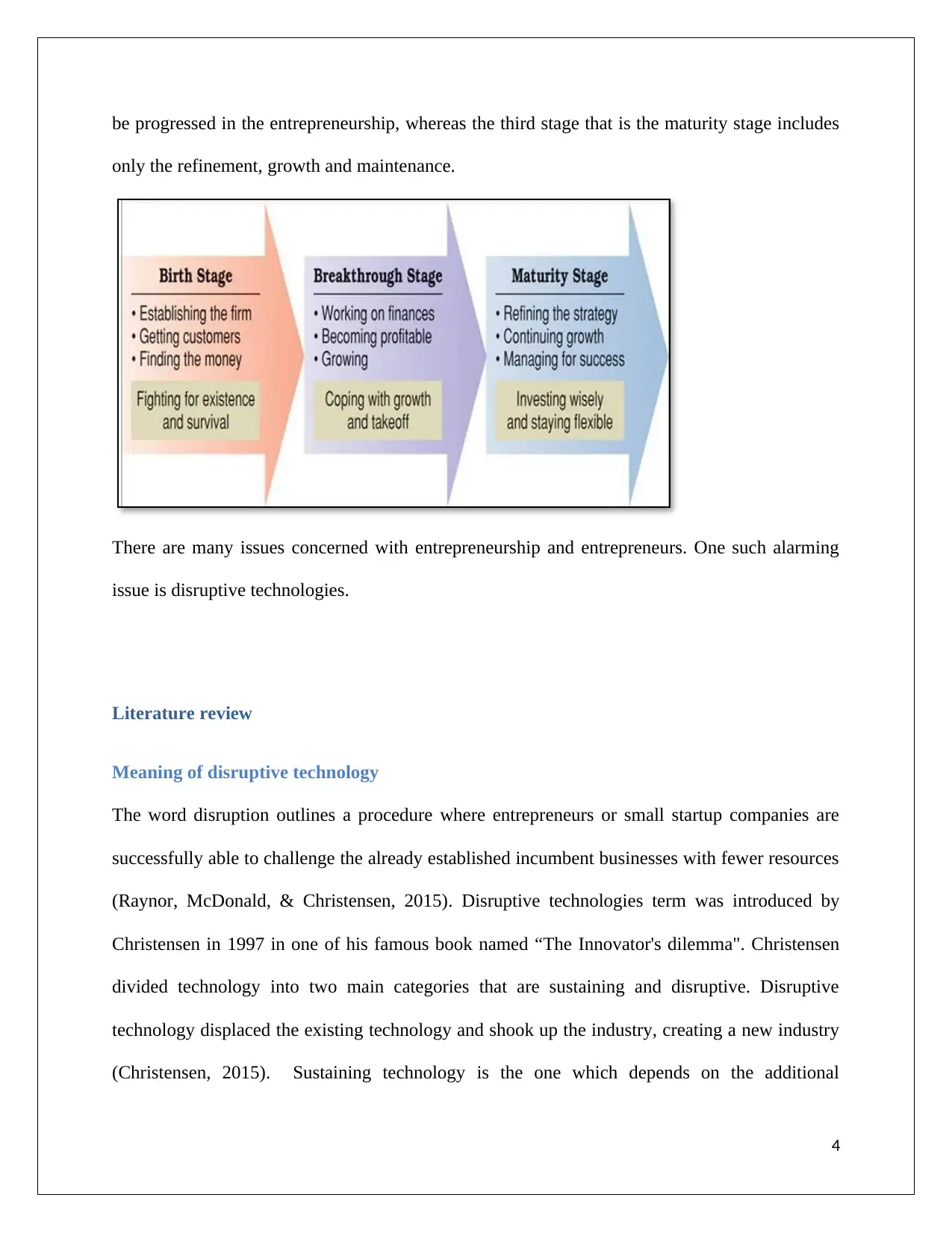
be progressed in the entrepreneurship, whereas the third stage that is the maturity stage includes
only the refinement, growth and maintenance.
There are many issues concerned with entrepreneurship and entrepreneurs. One such alarming
issue is disruptive technologies.
Literature review
Meaning of disruptive technology
The word disruption outlines a procedure where entrepreneurs or small startup companies are
successfully able to challenge the already established incumbent businesses with fewer resources
(Raynor, McDonald, & Christensen, 2015). Disruptive technologies term was introduced by
Christensen in 1997 in one of his famous book named “The Innovator's dilemma". Christensen
divided technology into two main categories that are sustaining and disruptive. Disruptive
technology displaced the existing technology and shook up the industry, creating a new industry
(Christensen, 2015). Sustaining technology is the one which depends on the additional
4
only the refinement, growth and maintenance.
There are many issues concerned with entrepreneurship and entrepreneurs. One such alarming
issue is disruptive technologies.
Literature review
Meaning of disruptive technology
The word disruption outlines a procedure where entrepreneurs or small startup companies are
successfully able to challenge the already established incumbent businesses with fewer resources
(Raynor, McDonald, & Christensen, 2015). Disruptive technologies term was introduced by
Christensen in 1997 in one of his famous book named “The Innovator's dilemma". Christensen
divided technology into two main categories that are sustaining and disruptive. Disruptive
technology displaced the existing technology and shook up the industry, creating a new industry
(Christensen, 2015). Sustaining technology is the one which depends on the additional
4
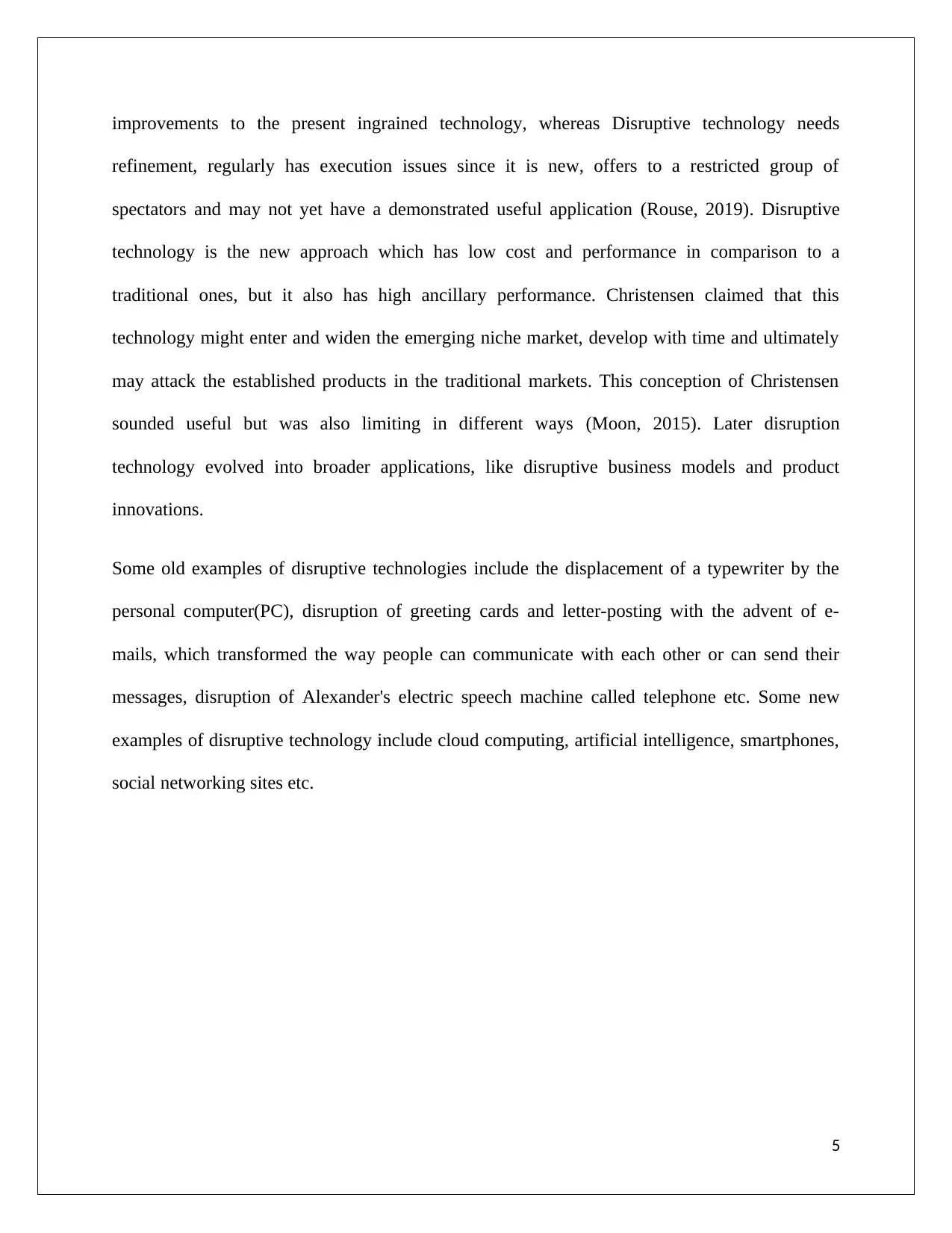
improvements to the present ingrained technology, whereas Disruptive technology needs
refinement, regularly has execution issues since it is new, offers to a restricted group of
spectators and may not yet have a demonstrated useful application (Rouse, 2019). Disruptive
technology is the new approach which has low cost and performance in comparison to a
traditional ones, but it also has high ancillary performance. Christensen claimed that this
technology might enter and widen the emerging niche market, develop with time and ultimately
may attack the established products in the traditional markets. This conception of Christensen
sounded useful but was also limiting in different ways (Moon, 2015). Later disruption
technology evolved into broader applications, like disruptive business models and product
innovations.
Some old examples of disruptive technologies include the displacement of a typewriter by the
personal computer(PC), disruption of greeting cards and letter-posting with the advent of e-
mails, which transformed the way people can communicate with each other or can send their
messages, disruption of Alexander's electric speech machine called telephone etc. Some new
examples of disruptive technology include cloud computing, artificial intelligence, smartphones,
social networking sites etc.
5
refinement, regularly has execution issues since it is new, offers to a restricted group of
spectators and may not yet have a demonstrated useful application (Rouse, 2019). Disruptive
technology is the new approach which has low cost and performance in comparison to a
traditional ones, but it also has high ancillary performance. Christensen claimed that this
technology might enter and widen the emerging niche market, develop with time and ultimately
may attack the established products in the traditional markets. This conception of Christensen
sounded useful but was also limiting in different ways (Moon, 2015). Later disruption
technology evolved into broader applications, like disruptive business models and product
innovations.
Some old examples of disruptive technologies include the displacement of a typewriter by the
personal computer(PC), disruption of greeting cards and letter-posting with the advent of e-
mails, which transformed the way people can communicate with each other or can send their
messages, disruption of Alexander's electric speech machine called telephone etc. Some new
examples of disruptive technology include cloud computing, artificial intelligence, smartphones,
social networking sites etc.
5
⊘ This is a preview!⊘
Do you want full access?
Subscribe today to unlock all pages.

Trusted by 1+ million students worldwide
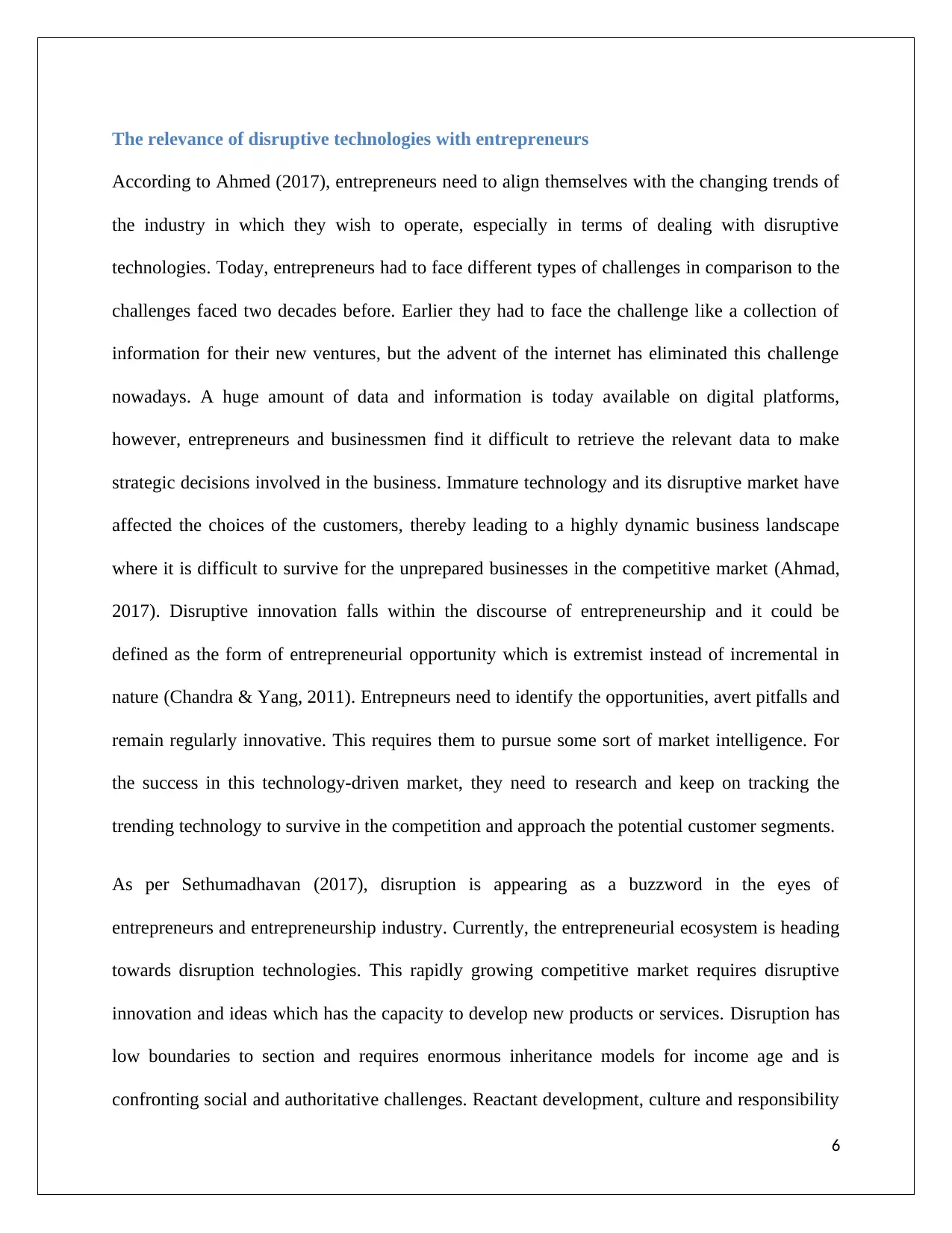
The relevance of disruptive technologies with entrepreneurs
According to Ahmed (2017), entrepreneurs need to align themselves with the changing trends of
the industry in which they wish to operate, especially in terms of dealing with disruptive
technologies. Today, entrepreneurs had to face different types of challenges in comparison to the
challenges faced two decades before. Earlier they had to face the challenge like a collection of
information for their new ventures, but the advent of the internet has eliminated this challenge
nowadays. A huge amount of data and information is today available on digital platforms,
however, entrepreneurs and businessmen find it difficult to retrieve the relevant data to make
strategic decisions involved in the business. Immature technology and its disruptive market have
affected the choices of the customers, thereby leading to a highly dynamic business landscape
where it is difficult to survive for the unprepared businesses in the competitive market (Ahmad,
2017). Disruptive innovation falls within the discourse of entrepreneurship and it could be
defined as the form of entrepreneurial opportunity which is extremist instead of incremental in
nature (Chandra & Yang, 2011). Entrepneurs need to identify the opportunities, avert pitfalls and
remain regularly innovative. This requires them to pursue some sort of market intelligence. For
the success in this technology-driven market, they need to research and keep on tracking the
trending technology to survive in the competition and approach the potential customer segments.
As per Sethumadhavan (2017), disruption is appearing as a buzzword in the eyes of
entrepreneurs and entrepreneurship industry. Currently, the entrepreneurial ecosystem is heading
towards disruption technologies. This rapidly growing competitive market requires disruptive
innovation and ideas which has the capacity to develop new products or services. Disruption has
low boundaries to section and requires enormous inheritance models for income age and is
confronting social and authoritative challenges. Reactant development, culture and responsibility
6
According to Ahmed (2017), entrepreneurs need to align themselves with the changing trends of
the industry in which they wish to operate, especially in terms of dealing with disruptive
technologies. Today, entrepreneurs had to face different types of challenges in comparison to the
challenges faced two decades before. Earlier they had to face the challenge like a collection of
information for their new ventures, but the advent of the internet has eliminated this challenge
nowadays. A huge amount of data and information is today available on digital platforms,
however, entrepreneurs and businessmen find it difficult to retrieve the relevant data to make
strategic decisions involved in the business. Immature technology and its disruptive market have
affected the choices of the customers, thereby leading to a highly dynamic business landscape
where it is difficult to survive for the unprepared businesses in the competitive market (Ahmad,
2017). Disruptive innovation falls within the discourse of entrepreneurship and it could be
defined as the form of entrepreneurial opportunity which is extremist instead of incremental in
nature (Chandra & Yang, 2011). Entrepneurs need to identify the opportunities, avert pitfalls and
remain regularly innovative. This requires them to pursue some sort of market intelligence. For
the success in this technology-driven market, they need to research and keep on tracking the
trending technology to survive in the competition and approach the potential customer segments.
As per Sethumadhavan (2017), disruption is appearing as a buzzword in the eyes of
entrepreneurs and entrepreneurship industry. Currently, the entrepreneurial ecosystem is heading
towards disruption technologies. This rapidly growing competitive market requires disruptive
innovation and ideas which has the capacity to develop new products or services. Disruption has
low boundaries to section and requires enormous inheritance models for income age and is
confronting social and authoritative challenges. Reactant development, culture and responsibility
6
Paraphrase This Document
Need a fresh take? Get an instant paraphrase of this document with our AI Paraphraser
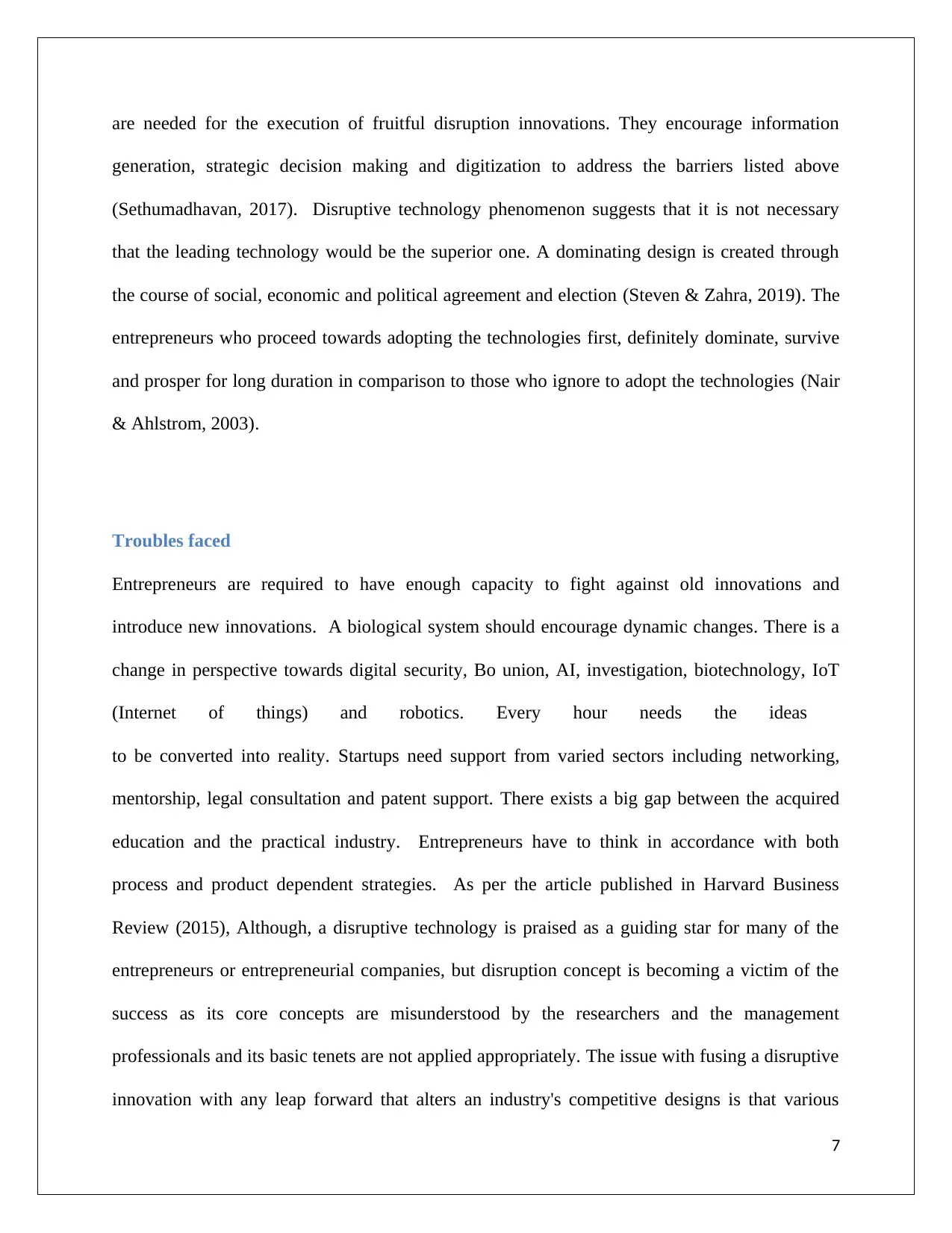
are needed for the execution of fruitful disruption innovations. They encourage information
generation, strategic decision making and digitization to address the barriers listed above
(Sethumadhavan, 2017). Disruptive technology phenomenon suggests that it is not necessary
that the leading technology would be the superior one. A dominating design is created through
the course of social, economic and political agreement and election (Steven & Zahra, 2019). The
entrepreneurs who proceed towards adopting the technologies first, definitely dominate, survive
and prosper for long duration in comparison to those who ignore to adopt the technologies (Nair
& Ahlstrom, 2003).
Troubles faced
Entrepreneurs are required to have enough capacity to fight against old innovations and
introduce new innovations. A biological system should encourage dynamic changes. There is a
change in perspective towards digital security, Bo union, AI, investigation, biotechnology, IoT
(Internet of things) and robotics. Every hour needs the ideas
to be converted into reality. Startups need support from varied sectors including networking,
mentorship, legal consultation and patent support. There exists a big gap between the acquired
education and the practical industry. Entrepreneurs have to think in accordance with both
process and product dependent strategies. As per the article published in Harvard Business
Review (2015), Although, a disruptive technology is praised as a guiding star for many of the
entrepreneurs or entrepreneurial companies, but disruption concept is becoming a victim of the
success as its core concepts are misunderstood by the researchers and the management
professionals and its basic tenets are not applied appropriately. The issue with fusing a disruptive
innovation with any leap forward that alters an industry's competitive designs is that various
7
generation, strategic decision making and digitization to address the barriers listed above
(Sethumadhavan, 2017). Disruptive technology phenomenon suggests that it is not necessary
that the leading technology would be the superior one. A dominating design is created through
the course of social, economic and political agreement and election (Steven & Zahra, 2019). The
entrepreneurs who proceed towards adopting the technologies first, definitely dominate, survive
and prosper for long duration in comparison to those who ignore to adopt the technologies (Nair
& Ahlstrom, 2003).
Troubles faced
Entrepreneurs are required to have enough capacity to fight against old innovations and
introduce new innovations. A biological system should encourage dynamic changes. There is a
change in perspective towards digital security, Bo union, AI, investigation, biotechnology, IoT
(Internet of things) and robotics. Every hour needs the ideas
to be converted into reality. Startups need support from varied sectors including networking,
mentorship, legal consultation and patent support. There exists a big gap between the acquired
education and the practical industry. Entrepreneurs have to think in accordance with both
process and product dependent strategies. As per the article published in Harvard Business
Review (2015), Although, a disruptive technology is praised as a guiding star for many of the
entrepreneurs or entrepreneurial companies, but disruption concept is becoming a victim of the
success as its core concepts are misunderstood by the researchers and the management
professionals and its basic tenets are not applied appropriately. The issue with fusing a disruptive
innovation with any leap forward that alters an industry's competitive designs is that various
7
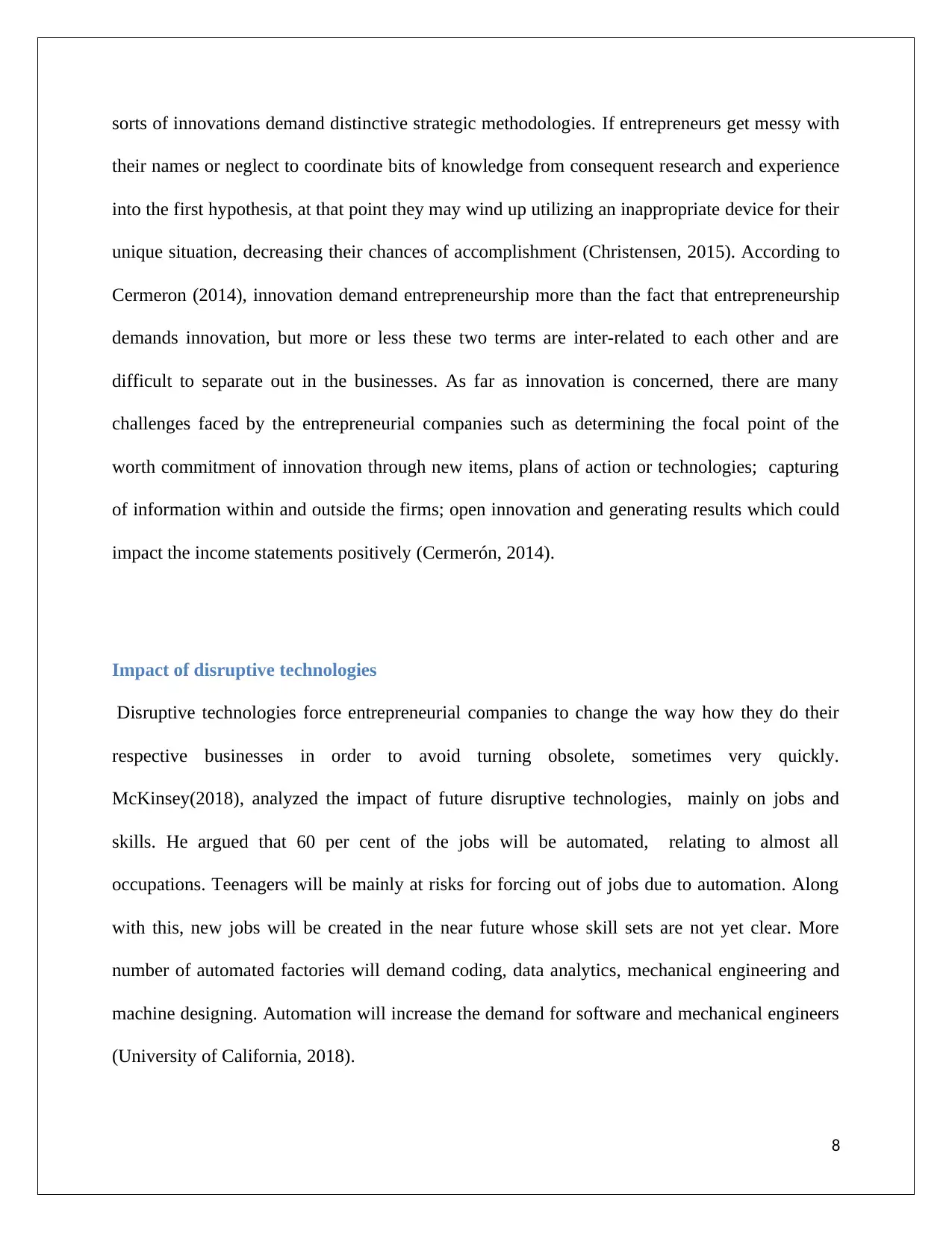
sorts of innovations demand distinctive strategic methodologies. If entrepreneurs get messy with
their names or neglect to coordinate bits of knowledge from consequent research and experience
into the first hypothesis, at that point they may wind up utilizing an inappropriate device for their
unique situation, decreasing their chances of accomplishment (Christensen, 2015). According to
Cermeron (2014), innovation demand entrepreneurship more than the fact that entrepreneurship
demands innovation, but more or less these two terms are inter-related to each other and are
difficult to separate out in the businesses. As far as innovation is concerned, there are many
challenges faced by the entrepreneurial companies such as determining the focal point of the
worth commitment of innovation through new items, plans of action or technologies; capturing
of information within and outside the firms; open innovation and generating results which could
impact the income statements positively (Cermerón, 2014).
Impact of disruptive technologies
Disruptive technologies force entrepreneurial companies to change the way how they do their
respective businesses in order to avoid turning obsolete, sometimes very quickly.
McKinsey(2018), analyzed the impact of future disruptive technologies, mainly on jobs and
skills. He argued that 60 per cent of the jobs will be automated, relating to almost all
occupations. Teenagers will be mainly at risks for forcing out of jobs due to automation. Along
with this, new jobs will be created in the near future whose skill sets are not yet clear. More
number of automated factories will demand coding, data analytics, mechanical engineering and
machine designing. Automation will increase the demand for software and mechanical engineers
(University of California, 2018).
8
their names or neglect to coordinate bits of knowledge from consequent research and experience
into the first hypothesis, at that point they may wind up utilizing an inappropriate device for their
unique situation, decreasing their chances of accomplishment (Christensen, 2015). According to
Cermeron (2014), innovation demand entrepreneurship more than the fact that entrepreneurship
demands innovation, but more or less these two terms are inter-related to each other and are
difficult to separate out in the businesses. As far as innovation is concerned, there are many
challenges faced by the entrepreneurial companies such as determining the focal point of the
worth commitment of innovation through new items, plans of action or technologies; capturing
of information within and outside the firms; open innovation and generating results which could
impact the income statements positively (Cermerón, 2014).
Impact of disruptive technologies
Disruptive technologies force entrepreneurial companies to change the way how they do their
respective businesses in order to avoid turning obsolete, sometimes very quickly.
McKinsey(2018), analyzed the impact of future disruptive technologies, mainly on jobs and
skills. He argued that 60 per cent of the jobs will be automated, relating to almost all
occupations. Teenagers will be mainly at risks for forcing out of jobs due to automation. Along
with this, new jobs will be created in the near future whose skill sets are not yet clear. More
number of automated factories will demand coding, data analytics, mechanical engineering and
machine designing. Automation will increase the demand for software and mechanical engineers
(University of California, 2018).
8
⊘ This is a preview!⊘
Do you want full access?
Subscribe today to unlock all pages.

Trusted by 1+ million students worldwide
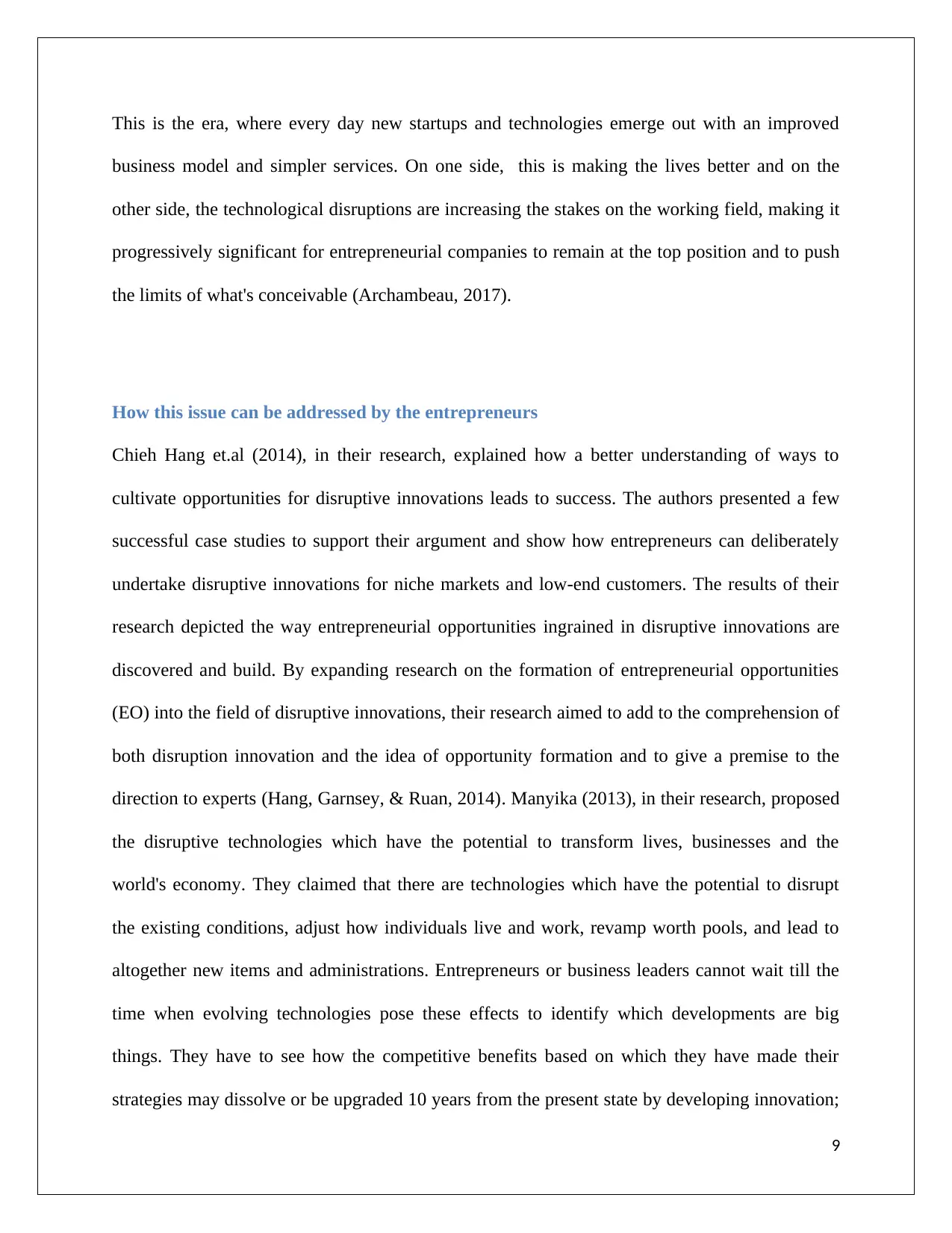
This is the era, where every day new startups and technologies emerge out with an improved
business model and simpler services. On one side, this is making the lives better and on the
other side, the technological disruptions are increasing the stakes on the working field, making it
progressively significant for entrepreneurial companies to remain at the top position and to push
the limits of what's conceivable (Archambeau, 2017).
How this issue can be addressed by the entrepreneurs
Chieh Hang et.al (2014), in their research, explained how a better understanding of ways to
cultivate opportunities for disruptive innovations leads to success. The authors presented a few
successful case studies to support their argument and show how entrepreneurs can deliberately
undertake disruptive innovations for niche markets and low-end customers. The results of their
research depicted the way entrepreneurial opportunities ingrained in disruptive innovations are
discovered and build. By expanding research on the formation of entrepreneurial opportunities
(EO) into the field of disruptive innovations, their research aimed to add to the comprehension of
both disruption innovation and the idea of opportunity formation and to give a premise to the
direction to experts (Hang, Garnsey, & Ruan, 2014). Manyika (2013), in their research, proposed
the disruptive technologies which have the potential to transform lives, businesses and the
world's economy. They claimed that there are technologies which have the potential to disrupt
the existing conditions, adjust how individuals live and work, revamp worth pools, and lead to
altogether new items and administrations. Entrepreneurs or business leaders cannot wait till the
time when evolving technologies pose these effects to identify which developments are big
things. They have to see how the competitive benefits based on which they have made their
strategies may dissolve or be upgraded 10 years from the present state by developing innovation;
9
business model and simpler services. On one side, this is making the lives better and on the
other side, the technological disruptions are increasing the stakes on the working field, making it
progressively significant for entrepreneurial companies to remain at the top position and to push
the limits of what's conceivable (Archambeau, 2017).
How this issue can be addressed by the entrepreneurs
Chieh Hang et.al (2014), in their research, explained how a better understanding of ways to
cultivate opportunities for disruptive innovations leads to success. The authors presented a few
successful case studies to support their argument and show how entrepreneurs can deliberately
undertake disruptive innovations for niche markets and low-end customers. The results of their
research depicted the way entrepreneurial opportunities ingrained in disruptive innovations are
discovered and build. By expanding research on the formation of entrepreneurial opportunities
(EO) into the field of disruptive innovations, their research aimed to add to the comprehension of
both disruption innovation and the idea of opportunity formation and to give a premise to the
direction to experts (Hang, Garnsey, & Ruan, 2014). Manyika (2013), in their research, proposed
the disruptive technologies which have the potential to transform lives, businesses and the
world's economy. They claimed that there are technologies which have the potential to disrupt
the existing conditions, adjust how individuals live and work, revamp worth pools, and lead to
altogether new items and administrations. Entrepreneurs or business leaders cannot wait till the
time when evolving technologies pose these effects to identify which developments are big
things. They have to see how the competitive benefits based on which they have made their
strategies may dissolve or be upgraded 10 years from the present state by developing innovation;
9
Paraphrase This Document
Need a fresh take? Get an instant paraphrase of this document with our AI Paraphraser
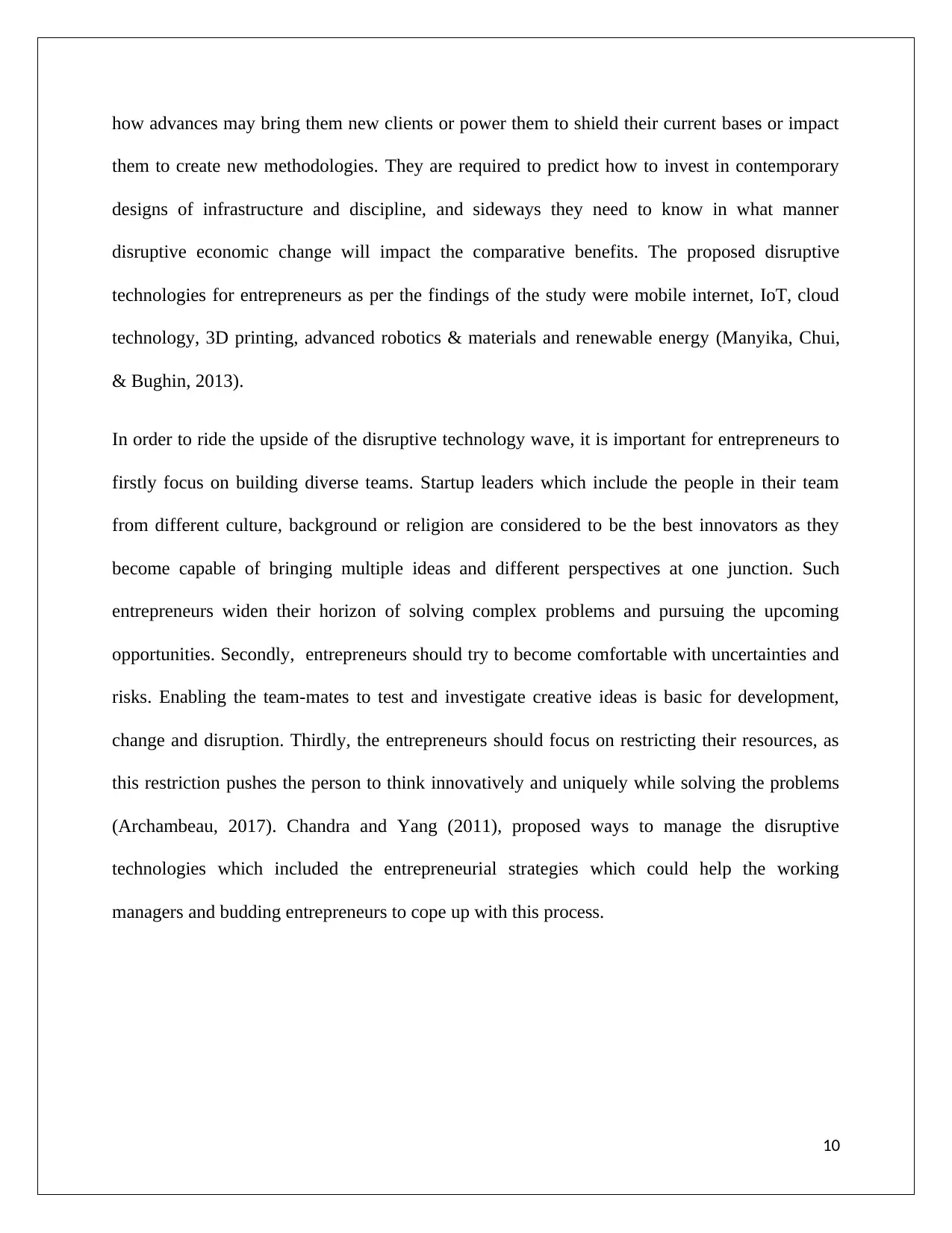
how advances may bring them new clients or power them to shield their current bases or impact
them to create new methodologies. They are required to predict how to invest in contemporary
designs of infrastructure and discipline, and sideways they need to know in what manner
disruptive economic change will impact the comparative benefits. The proposed disruptive
technologies for entrepreneurs as per the findings of the study were mobile internet, IoT, cloud
technology, 3D printing, advanced robotics & materials and renewable energy (Manyika, Chui,
& Bughin, 2013).
In order to ride the upside of the disruptive technology wave, it is important for entrepreneurs to
firstly focus on building diverse teams. Startup leaders which include the people in their team
from different culture, background or religion are considered to be the best innovators as they
become capable of bringing multiple ideas and different perspectives at one junction. Such
entrepreneurs widen their horizon of solving complex problems and pursuing the upcoming
opportunities. Secondly, entrepreneurs should try to become comfortable with uncertainties and
risks. Enabling the team-mates to test and investigate creative ideas is basic for development,
change and disruption. Thirdly, the entrepreneurs should focus on restricting their resources, as
this restriction pushes the person to think innovatively and uniquely while solving the problems
(Archambeau, 2017). Chandra and Yang (2011), proposed ways to manage the disruptive
technologies which included the entrepreneurial strategies which could help the working
managers and budding entrepreneurs to cope up with this process.
10
them to create new methodologies. They are required to predict how to invest in contemporary
designs of infrastructure and discipline, and sideways they need to know in what manner
disruptive economic change will impact the comparative benefits. The proposed disruptive
technologies for entrepreneurs as per the findings of the study were mobile internet, IoT, cloud
technology, 3D printing, advanced robotics & materials and renewable energy (Manyika, Chui,
& Bughin, 2013).
In order to ride the upside of the disruptive technology wave, it is important for entrepreneurs to
firstly focus on building diverse teams. Startup leaders which include the people in their team
from different culture, background or religion are considered to be the best innovators as they
become capable of bringing multiple ideas and different perspectives at one junction. Such
entrepreneurs widen their horizon of solving complex problems and pursuing the upcoming
opportunities. Secondly, entrepreneurs should try to become comfortable with uncertainties and
risks. Enabling the team-mates to test and investigate creative ideas is basic for development,
change and disruption. Thirdly, the entrepreneurs should focus on restricting their resources, as
this restriction pushes the person to think innovatively and uniquely while solving the problems
(Archambeau, 2017). Chandra and Yang (2011), proposed ways to manage the disruptive
technologies which included the entrepreneurial strategies which could help the working
managers and budding entrepreneurs to cope up with this process.
10
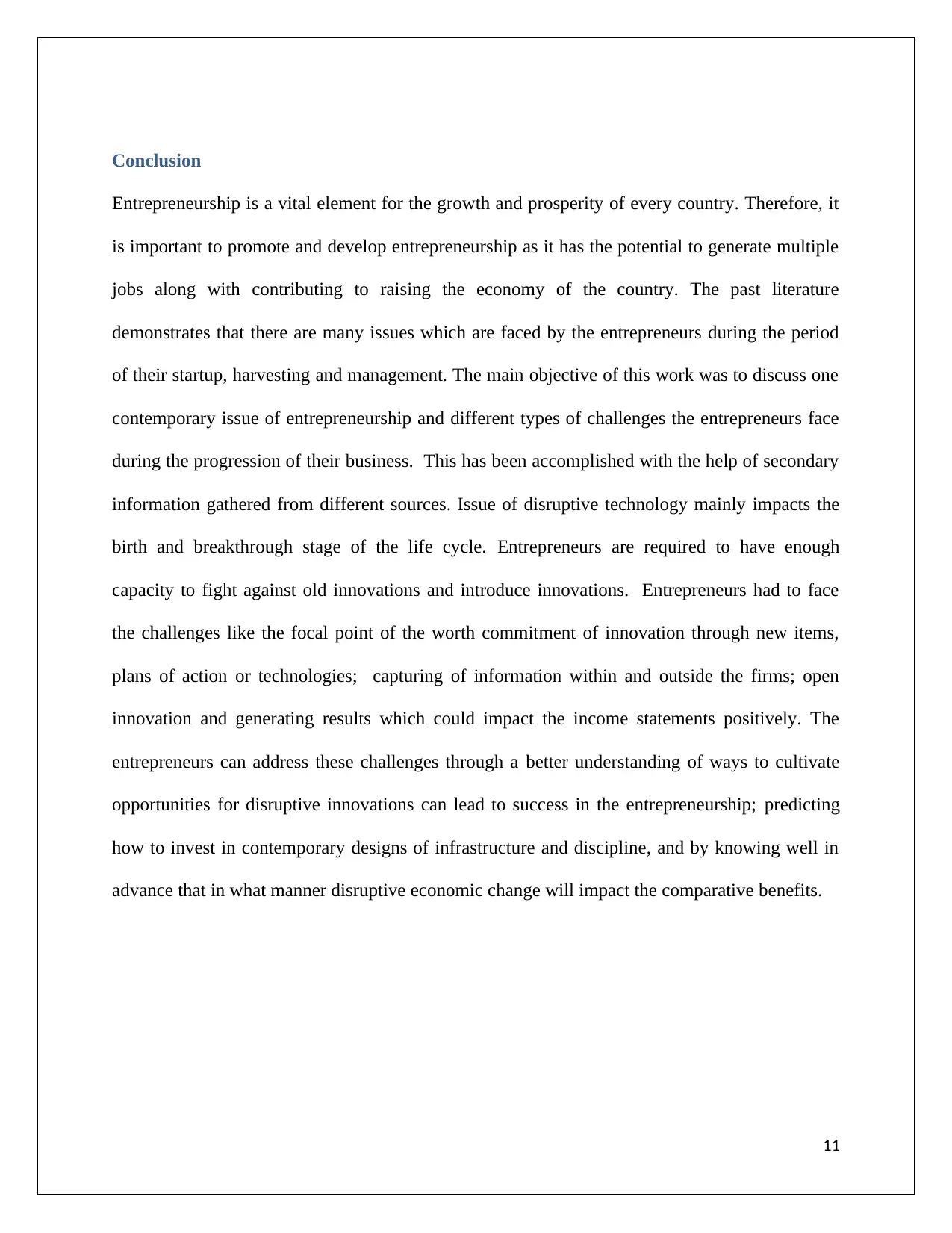
Conclusion
Entrepreneurship is a vital element for the growth and prosperity of every country. Therefore, it
is important to promote and develop entrepreneurship as it has the potential to generate multiple
jobs along with contributing to raising the economy of the country. The past literature
demonstrates that there are many issues which are faced by the entrepreneurs during the period
of their startup, harvesting and management. The main objective of this work was to discuss one
contemporary issue of entrepreneurship and different types of challenges the entrepreneurs face
during the progression of their business. This has been accomplished with the help of secondary
information gathered from different sources. Issue of disruptive technology mainly impacts the
birth and breakthrough stage of the life cycle. Entrepreneurs are required to have enough
capacity to fight against old innovations and introduce innovations. Entrepreneurs had to face
the challenges like the focal point of the worth commitment of innovation through new items,
plans of action or technologies; capturing of information within and outside the firms; open
innovation and generating results which could impact the income statements positively. The
entrepreneurs can address these challenges through a better understanding of ways to cultivate
opportunities for disruptive innovations can lead to success in the entrepreneurship; predicting
how to invest in contemporary designs of infrastructure and discipline, and by knowing well in
advance that in what manner disruptive economic change will impact the comparative benefits.
11
Entrepreneurship is a vital element for the growth and prosperity of every country. Therefore, it
is important to promote and develop entrepreneurship as it has the potential to generate multiple
jobs along with contributing to raising the economy of the country. The past literature
demonstrates that there are many issues which are faced by the entrepreneurs during the period
of their startup, harvesting and management. The main objective of this work was to discuss one
contemporary issue of entrepreneurship and different types of challenges the entrepreneurs face
during the progression of their business. This has been accomplished with the help of secondary
information gathered from different sources. Issue of disruptive technology mainly impacts the
birth and breakthrough stage of the life cycle. Entrepreneurs are required to have enough
capacity to fight against old innovations and introduce innovations. Entrepreneurs had to face
the challenges like the focal point of the worth commitment of innovation through new items,
plans of action or technologies; capturing of information within and outside the firms; open
innovation and generating results which could impact the income statements positively. The
entrepreneurs can address these challenges through a better understanding of ways to cultivate
opportunities for disruptive innovations can lead to success in the entrepreneurship; predicting
how to invest in contemporary designs of infrastructure and discipline, and by knowing well in
advance that in what manner disruptive economic change will impact the comparative benefits.
11
⊘ This is a preview!⊘
Do you want full access?
Subscribe today to unlock all pages.

Trusted by 1+ million students worldwide
1 out of 15
Related Documents
Your All-in-One AI-Powered Toolkit for Academic Success.
+13062052269
info@desklib.com
Available 24*7 on WhatsApp / Email
![[object Object]](/_next/static/media/star-bottom.7253800d.svg)
Unlock your academic potential
Copyright © 2020–2025 A2Z Services. All Rights Reserved. Developed and managed by ZUCOL.





